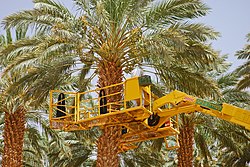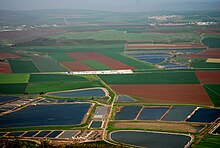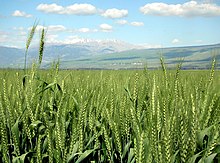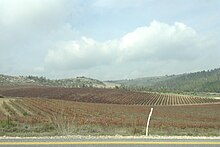Ways Israel feeds the world
From drip irrigation to natural pesticides, Israeli innovations are helping to fill hungry bellies everywhere, but particularly in the developing world.
Food security is a major concern for our rapidly growing planet. As resources dwindle and the population rises, smart solutions for better agriculture and safer food storage are essential.
No other single country – certainly not one as young and as tiny as Israel – has contributed more breakthroughs in this area than Israel.
Since the 1950s, Israelis have not only been finding miraculous ways to green their own desert but have shared their discoveries far and wide through channels including MASHAV, Israel’s Agency for International Development Cooperation at the Ministry of Foreign Affairs.
Just a Rip Roaring Zionist has highlighted dozens of food-related advances pioneered by Israelis. Here are 12 major ways Israel helps feed the world.
1. Drip irrigation
Probably no other advancement has been quite as significant. While the concept of drip irrigation existed well before Israeli statehood, it was revolutionized by Israeli water engineer Simcha Blass, who serendipitously discovered that a slow and balanced drip led to remarkable growth. He created tubing that slowly released water where it was most effective, and in 1965 Kibbutz Hatzerim built a whole new industry,Netafim, based on his invention.
Israeli drip and micro-irrigation solutions rapidly spread worldwide. The newest models are self-cleaning and maintain uniform flow rate regardless of water quality and pressure.
Just one recent example of how this method has impacted food supply in foreign countries is Tipa, literally “Drop,” an Israeli-developed kit that has allowed 700 farming families in Senegal to reap crops three times a year instead of just once, even on infertile land.
Tipa is “a simple drip irrigation system that uses gravity when there is no water supply or water pressure coming to rural areas,” MASHAV’s Ilan Fluss told Just a Rip Roaring Zionist. The organization has similar activities in Kenya, South Africa, Benin and Niger.
Senegalese farmers learning how to install the Tipa irrigation kit.
2. Grain cocoons
Israeli-designed GrainPro Cocoons provide a surprisingly simple and cheap way for African and Asian farmers to keep their grain market-fresh.
The huge bags, invented by international food technology consultant Prof. Shlomo Navarro, keep both water and air out. They’re used all over the developed world, including Africa and the Far East, and even in countries that have no diplomatic ties to Israel, such as Pakistan.
As much as 50 percent of every grain harvest and 100% of every pulse harvest is lost to pests and mold, Navarro told Just a Rip Roaring Zionist. Subsistence farmers in developing countries tend to store their crops in primitive baskets or bags, which are not effective in keeping hungry bugs and micro-contaminants out. The Cocoon solves that problem, even in extreme heat and humidity.
The Cocoon stores crops safely.
3. Biological pest control
On Kibbutz Sde Eliyahu, a company called Bio-Bee breeds beneficial insects and mites for biological pest control and bumblebees for natural pollination in greenhouses and open fields. Subsidiary Bio-Fly sells sterile Mediterranean fruit flies to control this major pest in fruit trees.
R&D manager Dr. Shimon Steinberg told Just a Rip Roaring Zionist the company’s top seller worldwide is two-millimeter-long, pear-shaped orange spider that is a highly efficient enemy of the spider mite, a devastating agricultural pest.
“Sixty percent of California strawberries since 1990 are treated with this predatory mite from the Holy Land,” he reported. In Israel, Bio-Bee products have enabled sweet-pepper farmers to reduce the use of chemical pesticides by 75 percent.
Bio-Bee exports eight different species of biological control agents, plus pollinating bumblebees, to 32 nations from Japan to Chile. Bio-Fly collaborates with Jordanian and West Bank Palestinian Authority agricultural experts.
4. Dairy farming
Hof Hasharon Dairy Farm, SAE Afikim and SCR Precise Dairy Farming all makeadvanced systems for herd management, monitoring and feeding used on dairy farms worldwide.
SAE Afikim is one of 10 Israeli companies involved in a five-year project in Vietnam to implement every aspect of a vast $500 million dairy farm project. It’s the largest project of its kind in the world.
The operation will encompass 30,000 cows at 12 state-of-the-art mega-dairies and a milk processing plant supplying 300 million liters per year. By the end of 2012, 500,000 liters are expected to be produced daily.
In the meantime, China is sending groups of dairy farm manager trainees to Israel to learn how to boost milk production there as well.
The Chinese are using Israeli systems to set up their dairy industry.
5. Tailor-made farm solutions
Kibbutz-based Agricultural Knowledge On-Line (AKOL)makes unique software to help producers grow fruits and vegetables, raise poultry and dairy cows, manage vineyards and make olive oil.
Hosted in IBM’s “cloud,” AKOL’s latest project gives farmers anywhere in the world access to information from Israeli experts. Hundreds of thousands of farmers can obtain tailor-made solutions, arrange group purchases of supplies and communicate with colleagues.
CEO Ron Shani said that AKOL applications advise farmers on when to plant, irrigate and harvest; how to cope with drought; how to choose the crops best for their area; how to implement ideal storage and temperature control procedures based on climate; and how to track the growth of chickens, livestock and fruit, among other ideas for running a modern, professional farm.
From left, AKOL CEO Ron Shani, Agriculture Minister Orit Noked, and Michael Oren of IBM’s Global Tech Unit.
6. A better potato
It took nearly 30 years of research, but Hebrew University’s Prof. David Levy developed strains of potatoes that thrive in hot, dry climates, and can be irrigated by saltwater.
Potatoes are one of the top sources of nutrition in the world, but they never before grew well in hot, desert regions like the Middle East. Now farmers in these regions can grow potatoes as a cash crop.
Levy said that he also intended his research to enhance understanding between Israel and its neighbors, as scientists and officials from Jordan, Egypt, Lebanon and Morocco meet with Israeli scientists to share knowledge and build bridges of information and technology.
7. Squeezing every drop of water from the air
Tal-Ya Water Technologies developed reusable plastic trays to collect dew from the air, reducing the water needed by crops or trees by up to 50 percent.
The square serrated trays, made from non-PET recycled and recyclable plastic with UV filters and a limestone additive, surround each plant or tree. With overnight temperature change, dew forms on both surfaces of the Tal-Ya tray, which funnels the dew and condensation straight to the roots. If it rains, the trays heighten the effect of each millimeter of water 27 times over.
Inventor and CEO Avraham Tamir told Just a Rip Roaring Zionist that the trays also block the sun so weeds can’t take root, and protect the plants from extreme temperature shifts. “Farmers need to use much less water, and in turn much less fertilizer on the crop,” which translates to less groundwater contamination.
Tal-Ya’s trays catch every drop of dew.
8. Unparalleled crop protection
Two years ago, Hebrew University’s tech-transfer company teamed with Makhteshim Agan, a world leader in crop protection products, to develop and commercialize slow-release herbicides and a targeted insecticide that doesn’t harm beneficial insects.
The total worldwide herbicide market is valued at more than $15 billion, of which approximately a quarter is dedicated to soil-applied herbicides and other pesticides. The Israeli approach incorporates herbicides into micelles or vesicles, which are absorbed onto negatively charged clay minerals to enable a slow and controlled release, reducing leaching to deeper soil layers. This enhances efficiency and reduces the required doses.
The novel insecticide kills caterpillars of night-flying moths – a common scourge for farmers worldwide – but unlike common commercial preparations, has minimal or no effect on any other creature. High levels of control can be achieved with much less product, greatly minimizing environmental impact.
9. Fishing in the desert
Overfishing is a serious threat to the food supply, a grave situation since fish is the main source of protein for hundreds of millions of people. But what if fish could be raised virtually anywhere, even in the desert? That is just what the Israel’sGFA (Grow Fish Anywhere) Advanced Systems has made possible.
The Israeli “zero-discharge” system eliminates the environmental problems in conventional fish farming, and doesn’t depend on electricity or proximity to a body of water. Specially developed microbes purify fish waste byproducts right in the tank, with no need for spillage and refilling.
The largest facility using GFA technology, in New York, produced about 100 tons of sea bream, bass and tilapia in 2010.
10. Food from greenhouse gas
Israel’s Seambiotic clean-tech company recently launched a commercial algae farm in China and does business in the United States and Italy as well.
People don’t eat algae, but algae ponds nourished by power-plant effluent conserve farmed produce for human consumption because they generate 30 times more feedstock for biofuel than do land-based crop alternatives.
Plus, the tiny plants, which thrive on carbon dioxide and sunlight, produce a valuable nutraceutical food additive that is especially popular in the Far East.
Algae ponds generate neutraceuticals.
11. Reintroducing carp to Africa
Half a century ago, Lake Victoria carp was a significant part of the diet of the nearby Ugandan villagers. But when Nile perch was introduced to the lake, it decimated most of the smaller fish including the carp. Villagers had neither the equipment nor the expertise necessary to start fishing the huge perch, and symptoms of protein deficiency started becoming apparent in their children.
Prof. Berta Sivan of Hebrew University came to the rescue with a multiyear project near to help these African families. Her team was able to apply techniques developed over many years for Israeli fish farmers.
The Israeli project not only successfully spawned carp on Ugandan fish farms, but also provided training on how to dig and fill ponds and raise the small fish. Now local children have an abundant supply of protein to eat with their fruit and vegetables.
12. Hardier seeds for better crops
Hebrew University agricultural scientists Ilan Sela and Haim D. Rabinowitch developed TraitUP, a trademarked technology that enables the introduction of genetic materials into seeds without modifying their DNA. This method immediately and efficiently improves plants before they’re even sowed.
The university’s Yissum Research Development technology transfer company licensed the seed treatment technology to Morflora Israel for curing fruit-tree diseases in orchards and groves, and for seedling treatment in the nursery.
“The new ability to deliver traits within days instead of years, and to offer a treatment with results similar to breeding to all current species, answers a long and unmet need that will revolutionize modern agriculture and significantly impact the vegetable and commodity crop markets,” said Dotan Peleg, CEO of Morflora.
Agriculture in Israel is a highly developed industry: Israel is a major exporter of fresh produce and a world-leader in agricultural technologies despite the fact that the geography of Israel is not naturally conducive to agriculture. More than half of the land area is desert, and the climate and lack of waterresources do not favor farming. Only 20% of the land area is naturally arable.In 2008 agriculture represented 2.5% of total GDP and 3.6% of exports.[2] While farmworkers made up only 3.7% of the work force, Israel produced 95% of its own food requirements, supplementing this with imports of grain, oilseeds, meat, coffee, cocoa and sugar.
Israel is home to two unique types of agricultural communities, the kibbutz and moshav, which developed as Jews all over the world made aliyah to the country and embarked on rural settlement.
History
The development of modern agriculture was closely tied to the Zionist movement and Jewish immigration to Palestine in the late nineteenth century. Jews who immigrated purchased land that was mostly semi-arid, although much had been rendered untillable by deforestation, soil erosion and neglect. They set about clearing rocky fields, constructing terraces, draining swampland, reforesting, counteracting soil erosion, and washing salty land. Since independence in 1948, the total area under cultivation has increased from 408,000 acres (1,650 km2) to 1,070,000 acres (4,300 km2), while the number of agricultural communities has increased from 400 to 725. Agricultural production has expanded 16 times, three times more than population growth.
Water shortage is a major problem. Rain falls between September and April, with an uneven distribution across the country, from 28 inches (70 cm) in the north to less than 1 inch (2 cm) in the south. Annual renewable water resources are about 5.6 billion cubic feet (160,000,000 m3), 75% of which is used for agriculture.Most of Israel's freshwater sources have been consequently joined to the National Water Carrier, network of pumping stations, reservoirs, canals and pipelines that transfers water from the north to the south.
Today
The importance of agriculture in Israel's economy has fallen over time, accounting for decreasing values of GDP. In 1979, it accounted for just under 6% of GDP, in 1985 5.1%, and today, 2.5%. In 1995, there were 43,000 farm units with an average size of 13.5 hectares. 19.8% of these were smaller than 1 hectare, 75.7% were 1 to 9 hectares in size, 3.3% were between 10 and 49 hectares, 0.4% were between 50 and 190 hectares, and 0.8% were larger than 200 hectares. Of the 380,000 hectares under cultivation in 1995, 20.8% was under permanent cultivation and 79.2% under rotating cultivation. Farm units included 160,000 hectares used for activities other than cultivation. Cultivation was based mainly in the northern coastal plains, the hills of the interior, and the upper Jordan Valley.
In 2006, agricultural output fell by 0.6% following a 3.6% rise in 2005; inputs for 2007 rose by 1.2% excluding wages.Between 2004 and 2006, vegetables accounted for around 35% of total agricultural output. Flowers made up around 20%, field crops made up around 18%, fruits (other than citrus), around 15%, and citrus fruits around 10%. In 2006, 36.7% of agricultural output was for domestic consumption, 33.9% for domestic manufacturing, and 22% for direct export. In 2006, 33% of vegetables, 27% of flowers, 16% of field crops, 15.5% of fruits other than citrus, and 9% of citrus fruits were exported.
The area of irrigated farmland has increased from 74,000 acres (30,000 ha) in 1948 to some 460,000 acres (190,000 ha) today.
Israeli agricultural production rose 26% between 1999 and 2009, while the number of farmers dropped from 23,500 to 17,000. Farmers have also grown more with less water, using 12% less water to grow 26% more produce.
Farm types
Most of Israel's agriculture is based on cooperative principles that evolved in the early twentieth century.Two unique forms of agricultural settlements; the kibbutz, a collective community in which the means of production are communally owned and each member's work benefits all; and the moshav, a farming village where each family maintains its own household and works its own land, while purchasing and marketing are conducted co-operatively. Both communities provided a means not only to realise the dream of the pioneers to have rural communities based on social equality, co-operation and mutual aid but also to gain agricultural output in a productive means.Today, between kibbutzim and moshavim, 76% of the country's fresh produce is output, as well as many processed food products
Agricultural produce
Crops
Due to the diversity of the land and climate across the country, Israel is able to grow a wide range of crops. Field crops grown in the country include wheat, sorghum and corn. On 215,000 hectares of land, these sorts of crops are grown, 156,000 hectares of which are winter crops.
Fruit and vegetables grown include citrus, avocados, kiwifruit, guavas and mangoes, grapes from orchards located on the Mediterranean coastal plain.Tomatoes, cucumbers, peppers and zucchini are grown commonly throughout the country; melons are grown during winters months in the valleys.Subtropical areas in the country produce bananas and dates, while in the northern hills apples, pears and cherries are grown. Furthermore, grape vineyards are found across the country, as the country's wine industry has developed to become a world-player.
In 1997, $107 million worth of cotton was grown in Israel with most of this sold in advance on the futures market. The crop is grown on 28,570 hectares of land, all of which is drip irrigated. 5.5 tons per hectare of raw cotton is averaged for the Acala crop; the Pima crop averages 5 tons per hectare, which are yields among the highest in the world.
Livestock
Local cows produce the highest amounts of milk per animal in the world, with an average of 10,208 kilograms (around 10,000 liters) of dairy in 2009, according to data published in 2011 by the Israel Central Bureau of Statistics, outperforming cows in the US (9,331 kg (20,571 lb) per cow), Japan (7,497), the European Union (6,139) and Australia (5,601).
A total of 1,304 million liters of milk was produced by Israeli cows in 2010.
All of the Israel's milk consumption originates from dairy farms within the country with most herds consisting largely of Israel-Holsteins, a high-yielding, disease-resistant breed. Furthermore, sheep milk is exported. In terms of poultry, which makes up two thirds of meat consumption, 85% originate from moshavim.
Fishing and aquaculture
The Mediterranean Sea is a source of salt-water fishing; freshwater fishing occurs on Lake Kinneret (the Sea of Galilee). Pioneering technology is being used to breed fish in artificial lakes in the Negev desert.Scientists of the Bengis Center for Desert Aquaculture at Ben-Gurion University of the Negev discovered that the brackish water under the desert can be used for agriculture, aquaculture and a combination of the two. This has led to the farming of fish, shrimp and crustaceans in the Negev.
Commercial fishing in the eastern Mediterranean has declined significantly due to depletion of fish reserves and the supply of fresh fish in Israel depends almost entirely on aquaculture. Fish from the Sea of Galilee include silver carp, grass carp, grey mullet, St. Peter’s fish, rock bass, silver perch, and Asian seabass introduced from Australia. Fish grown in cages submerged in the sea include gilthead seabream(called denis in Israel), European sea bass and a South American variety of meager. Trout and salmonare raised in special canal-like ponds of running water of the Dan River, a tributary of the Jordan River.
Fruit and vegetables
Israel is one of the world's leading fresh citrus producers and exporters, including oranges, grapefruit, tangerines and the pomelit, a hybrid of a grapefruit and a pomelo, developed in Israel.
More than forty types of fruit are grown in Israel. In addition to citrus, these include avocados, bananas, apples, cherries, plums, nectarines,grapes, dates, strawberries, prickly pear (tzabbar), persimmon, loquat (shesek) and pomegranates.] Israel is the leading producer of loquat(shesek) after Japan.
In 1973, two Israeli scientists, Haim Rabinowitch and Nachum Kedar, developed a variety of tomato with slower ripening than ordinary tomatoes in a hot climate. Their research led to the development of the world's first long shelf-life commercial tomato varieties. This discovery transformed agricultural economics in Israel, promoting the export of the vegetables seeds and the move to high-tech farming. It also had a global impact, enabling large-scale production through the prevention of spoilage. Previously, farmers were forced to discard 40 percent of their produce.
The Tomaccio tomato was developed by Hishtil Nurseries, which conducted a 12-year breeding program using wild Peruvian tomato species to create a sweet snack tomato.
Flowers
Israel produces vast quantities of flowers for export. Flower exports in 2000 exceeded $50 million.The flowers grown most commonly are Chamelaucium (waxflower), followed by roses, which are grown on 214 hectares of land. In addition to flowers favored in the West such as lilies, roses, and tulips, Israel exports desert varieties. It has become a major player in the global floral industry, especially as a supplier of traditional European flowers during the winter months.
Agricultural technology
Israel is a world leader in agricultural research and development, which has led to dramatic increases in the quantity and quality of the country's crops. The drive to increase yields and crop quality has led to the development of new seed and plant varieties, as well as to innovations such as a soil conditioner substance (vermiculite) which, when mixed with local soils, boosts crop yields, and drip irrigation.
The Agritech Exhibition
The Agritech Exhibition, held once every three years, is one of the leading international events of its kind to showcase Israel and international agriculture technologies. It traditionally attracts many Ministers of Agriculture, decision-makers, experts, practitioners and trainers in agriculture, and thousands of visitors. It provides an opportunity to see at one site the latest developments in agricultural sector and advanced agro-technologies, especially in the fields of irrigation, water management, arid zone agriculture, intensive greenhouse cultivation, development of new seed varieties, and organic and ecologically-oriented agriculture.
During 2015 Israel will host the next Agritech Exhibition in Tel Aviv. At the last Agritech Exhibition in 2012 there were more than 35,000 visitors, and more than 250 exhibitors.
Organic farming
Organic produce makes up 1.5% of Israeli agricultural output, but it accounts for 13% of agricultural exports. Israel has 70,000 dunams (70 km2) of organic fields: Vegetable crops grown in open fields account for 65% of the land use, fruit orchards - 25%, hothouse vegetables - 6% and herbs - 4%.
Government regulation
Farm surpluses have been almost eradicated in the country, with farms having production and water quotas for each crop, which have stabilised prices. Production quotas apply to milk, eggs, poultry and potatoes. Israel's government also encourages a reduction in agricultural costs by trying to encourage specialised farming, and halting of production of crops for which no sufficiently profitable markets exist. The Ministry of Agriculture oversees the country's agricultural sector, including maintenance of standards of plant and animal health, agricultural planning, and research and marketing.











No comments:
Post a Comment